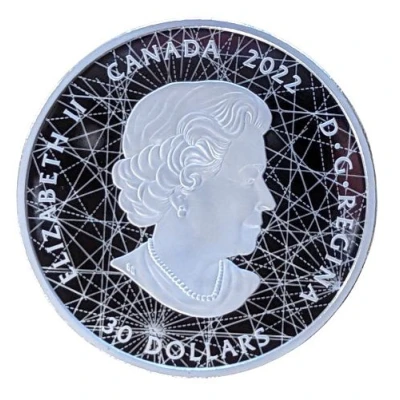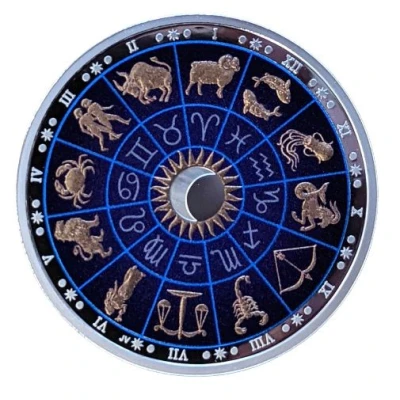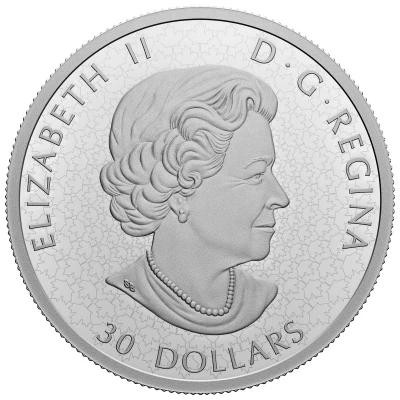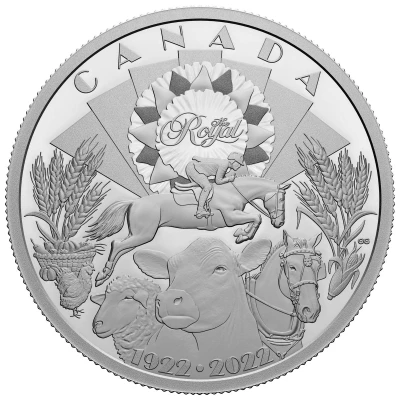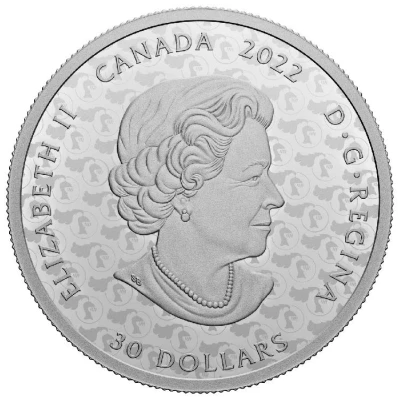
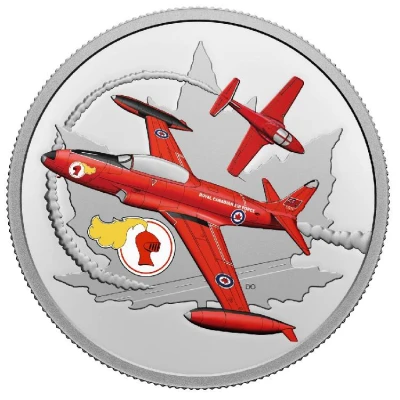

30 Dollars - Elizabeth II The Red Knight
2022 year| Silver (.9999) | 62.69 g | 50 mm |
| Issuer | Canada |
|---|---|
| Queen | Elizabeth II (1952-2022) |
| Type | Non-circulating coin |
| Year | 2022 |
| Value | 30 Dollars 30 CAD = USD 22 |
| Currency | Dollar (1858-date) |
| Composition | Silver (.9999) |
| Weight | 62.69 g |
| Diameter | 50 mm |
| Shape | Round |
| Technique | Milled, Engraved |
| Orientation | Medal alignment ↑↑ |
| Updated | 2024-10-04 |
| Numista | N#416044 |
|---|---|
| Rarity index | 93% |
Reverse
Your coins reverse pays tribute to the Red Knight, the Royal Canadian Air Force Training Command’s famous aerobatic performer from 1958 to 1969. Historical liaison was provided by authors J.C. Corrigan and D.V. Dempsey. To represent that timespan, the Canadair-built T-33 Silver Star is shown performing a manoeuvre alongside its eventual replacement, the Canadair-designed and built CT-114 Tutor (background). Accompanied by the red, gold and white Red Knight emblem, both aircraft are painted in their distinctive red colour schemes of the 1960s and set against the RCAF Roundel’s (pre-1965) maple leaf.
Lettering:
ROYAL CANADIAN AIR FORCE
21574
DO
Designer: David Oram
Edge
Serrated
Comment
https://www.youtube.com/watch?v=2Z8WzEVZ5bA&t=3s
The Red Knight’s aerobatic performance
Before the Snowbirds, there was the Red Knight! From 1958 until 1969, the Red Knight delighted spectators across Canada and the United States with awe-inspiring aerobatic displays. The Royal Canadian Air Force’s (RCAF) solo jet-aerobatic performer was equipped with the T-33 Silver Star (or “T-Bird”, CT-133) and later, the CT-114 Tutor, which were decked out in a bright colour scheme, iconic red. These aircraft, along with the distinctive knight’s helmet emblem they bore, have been colourfully recreated on this 99.99% pure silver tribute to the legendary (and much loved) Red Knight, whose show-stopping manoeuvres inspired a generation of air enthusiasts and enriched Canada’s aviation heritage.
FEATURES -
Vintage colours
The Red Knight’s bright paint scheme and markings made it easy to spot, and its distinctive red colour has been recreated on this selectively coloured coin which has been crafted in 2 oz. of 99.99% fine silver.
Includes Red Knight emblem
The emblem of the Red Knight is also featured on this coin! The Red Knight’s helmet with golden plume was displayed on the aircraft’s nose from 1961 to 1969. The emblem is also subtly laser-engraved on your coin’s obverse, where this repeating element catches the light when the coin is tipped.
DID YOU KNOW?
Four T-33 aircraft were part of the Red Knight program from 1958 to 1968. One of them, RCAF serial 21574 (1961 to 1964), is on display at the Canada Aviation and Space Museum in Ottawa, Ontario, where you can get a close view of its day-glo red paint scheme and the Red Knight emblem on its nose—that emblem also appears on this coin! Another of the original Red Knights, serial 21630, is on display in Saskatoon and there are several other tributes to the Red Knight across Canada. The last remaining Tutor to have served as the Red Knight, RCAF serial 26153, is now on display in its original Golden Centennaires colours at the CFB Borden Museum. Following its Red Knight tour, this same Tutor served six years on the Snowbirds, including as Snowbird 1 in 1975-1976.
A few variations on the standard Red Knight colour scheme were introduced through the years—for example, the Tutor was painted vermillion red (instead of the original day-glo red) and had a white line that stretched from nose to tail. As for the Red Knight insignia, it started out as a black silhouette of a knight’s helmet in 1959; the more colourful version, the one reproduced on your coin’s reverse, was introduced in 1961 and served as the emblem for the remainder of the Red Knight program.
The CT-114 Tutor is the same aircraft type that is currently used by the Canadian Forces Snowbirds, 431 Air Demonstration Squadron.
The Red Knight was among the 2020 inductees to Canada’s Aviation Hall of Fame (CAHF) as the recipient of the Belt of Orion Award for Excellence, a well-deserved honour.
About the Red Knight
A forerunner of the Canadian Forces Snowbirds, the Red Knight originated in Trenton, Ontario, and was active from 1958 to 1969. Although it was originally authorized to perform in just three air shows, the Royal Canadian Air Force Training Command’s solo aerobatic performer proved to be a hit with spectators and went on to make more than 600 air show appearances throughout its 12-year run. Its ability to perform manoeuvres within the confines of an airfield made it well suited for air shows in small communities and venues that could not accommodate larger display teams.
For the first three years, the Red Knight consisted of a single aircraft, a pilot and a support technician. Ultimately, a total of 17 pilots and two aircraft types—the T-33 from 1958 to mid-1968 and the Tutor in 1968 and 1969—took up the mantle of the Red Knight. The base of operations moved to RCAF Station Saskatoon in 1959, RCAF Station Portage la Prairie in 1961 and RCAF Station Moose Jaw in 1964 before returning to CFB Portage la Prairie in 1967. At the end of that air show season, the Red Knight was awarded the Centennial Medal for its “valuable service to the nation” after completing more than 100 performances, including flypasts and air shows alongside the Canadian Armed Forces Golden Centennaires during Expo 67.
Budget cuts and a fatal accident resulted in the program’s untimely cancellation in early 1970. But the Red Knight will always hold a special place in Canadian aviation history as a prolific performer and one of the longest-running military aerobatic displays—in fact, its total number of performances is third only to today’s Snowbirds and CF-18 solo aerobatic displays which have been ongoing since 1971 and 1983 respectively.
Interesting fact
The Elizabeth II (The Red Knight) coin is a non-circulating coin minted by the Royal Canadian Mint in 2022. One interesting fact about this coin is that it features a unique red-colored portrait of Queen Elizabeth II, which is unlike any other coin that has been minted by the Royal Canadian Mint in the past. The red color is achieved through the use of a specialized technique that involves applying a thin layer of red enamel to the coin's surface. This process not only gives the coin its distinctive red color but also adds an extra layer of depth and dimension to the design. The coin's unique coloration and design make it a standout piece in the world of numismatics and a highly sought-after collector's item.
Price
| Date | Mintage | VG | F | VF | XF | AU | UNC |
|---|---|---|---|---|---|---|---|
| 2022 | 6500 | - | - | - | - | - | - |
Values in the table are based on evaluations by sales realized on Internet platforms. They serve as an indication only for 30 Dollars - Elizabeth II (The Red Knight) 2022 coin.
